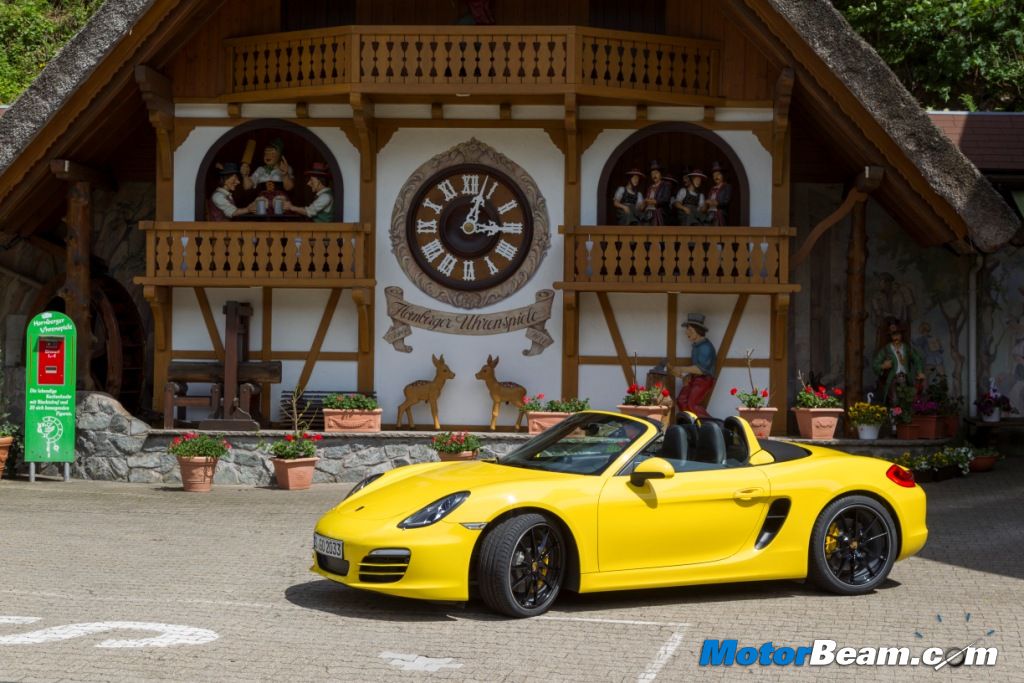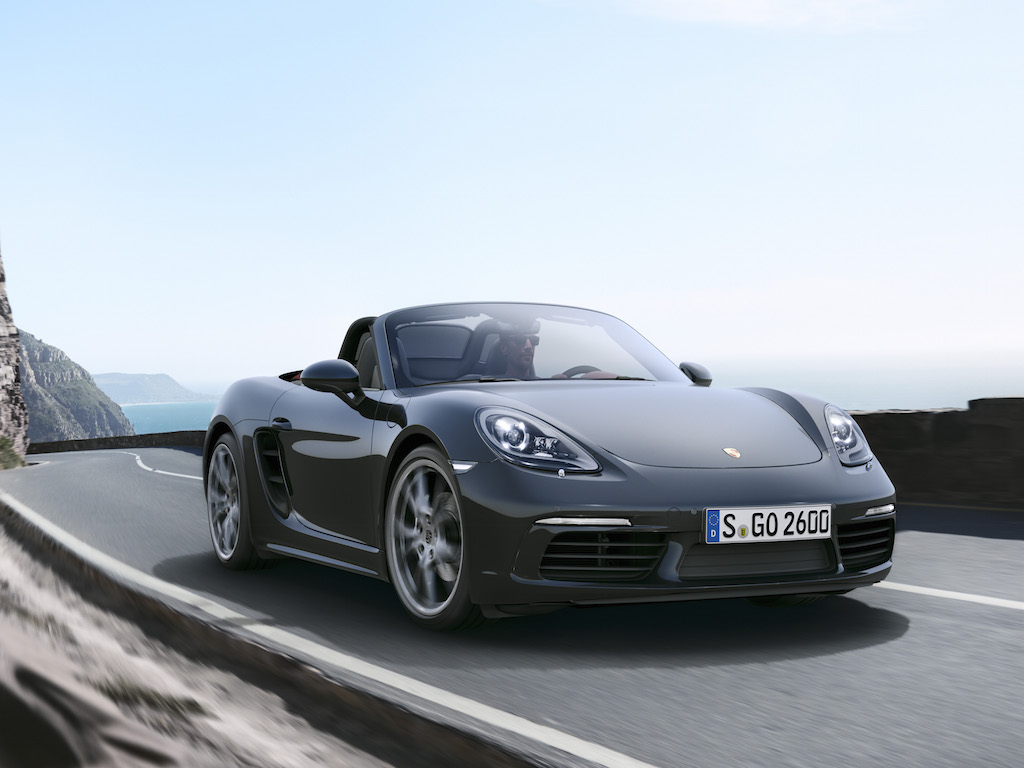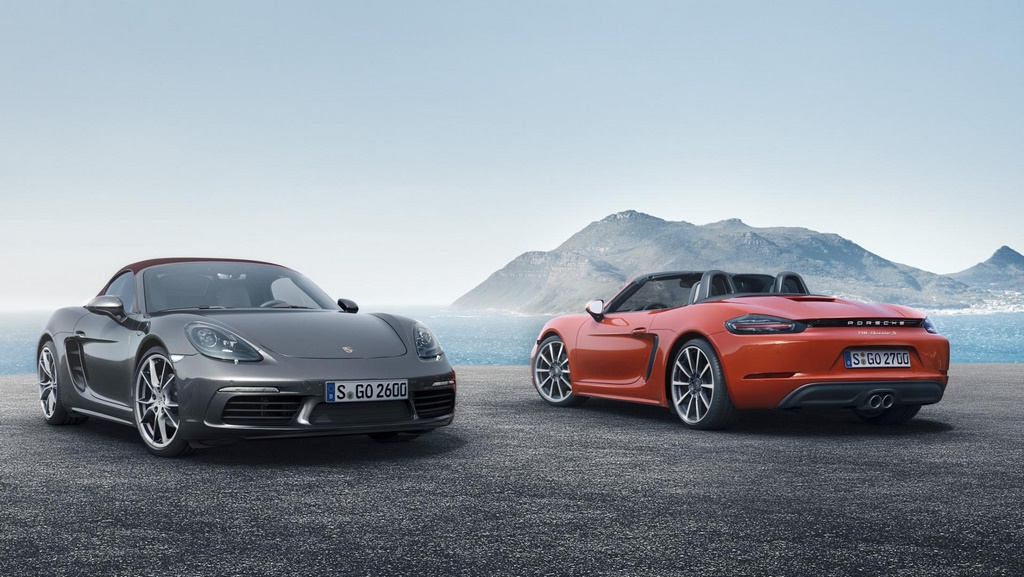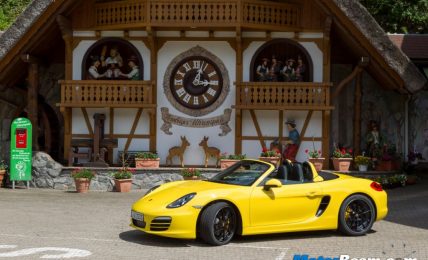Porsche Boxster S Review
Car Tested: 2013 Porsche Boxster S
Price OTR Mumbai: Rs. 85,19,450/-
Porsche’s latest Boxster appears more mature than the outgoing model and a closer inspection gives away most of the story.
Fifteen years ago, the original Porsche Boxster made its debut. Porsche’s classic and successful approach of creating an affordable mid-engined sportscar with engines in the right place became the backbone of the Boxster and its derivatives such as the Cayman. That first-generation Porsche was fun to drive and arguably the most sporty and competent of the then Teutonic trio represented by Mercedes-Benz SLK, BMW Z3 and inexpensive sports cars like the Mazda Miata. However, from the very beginning, there was a massive gap between the performance and handling of the mid engined and rear engined siblings, the Boxster and the classic 1963 911. Over the years Porsche has tried to narrow the gap between the two models and never in its history has Porsche ever neglected the Boxster. In fact, the sports car maker kept it fresh and as a result each successive generation of the Porsche Boxster improved significantly.
One of the prime objectives with the new Porsche Boxster was to make the car more attractive, package it with improved hardware and secretly somewhere try to narrow the performance gap between the model and its illustrious 911 sibling. The starting point for such exercises usually begins with what you don’t see. Actually, there’s almost nothing that’s been carried over from the earlier 987 in the new Boxster, also known as the 981 internally. It is based on the all-new seventh generation 911 and that means there’s a completely revamped chassis which sports a longer wheelbase and a wider track also. Like the new 911, the new Boxster is longer, slightly wider and a half-inch lower than before.
[flickr size=”center” float=”medium”]http://www.flickr.com/photos/motorbeam/8277221849/[/flickr]
Exteriors – In the latest Boxster, a strong crease runs along the inside edge of the fenders, which makes them appear less rounded than those of the previous model, or even the new 911. On one hand the car appears mature and a bit aggressive with its lowered stance. There are more than just soft hints of the Carrera GT in the design when you look at how the bespoke doors have been designed and merged with the sculpted side panels which nicely flow into deep air scoops just behind the doors. The new windscreen has also been raked further to allow vertically stacking the 918-inspired cluster headlamps and there’s a rear spoiler uniquely integrated with the tail lamps. What we liked in the overall look was its simplicity and avoidance of excess ornamentation that has helped in giving the new Boxster its mature look.
[flickr size=”center” float=”medium”]http://www.flickr.com/photos/motorbeam/8278278448/[/flickr]
While dimensions have grown and more kit added, overall weight of the Boxsters have actually gone down. Thanks to smart usage of hybrid construction including aluminum space frame and in sheet metal, the weight of the Boxster has been knocked down by 25kg and in the ‘S’ by 35kg. And when one factored in the additional equipment on board, this is a tremendous achievement by the engineers. Some parts from the bin that have been used include the Carrera’s new electro-mechanical steering and front suspension. The only component that comes from the outgoing model is the rear axle. The roadster uses a fabric top and can open in lightning fast nine seconds.
[flickr size=”center” float=”medium”]http://www.flickr.com/photos/motorbeam/8277220117/[/flickr]
Interiors – Interior space is excellent, and an extra inch of rearward travel has been added to the seats. The cabin has been upgrade with latest styling cues from the family and the tall centre Carrera GT-inspired console that houses the shifter and a number of secondary switches are the biggest evidence of this. Porsche’s build quality has significantly improved over the years and there’s a feel of bespoke touches everywhere. The car’s new seats come from the 911 which offer terrific lateral support and comfort. There’s the usual assortment of goodies, beginning with the large tachometer at the centre of the instrument cluster, paddle shift-equipped steering wheel and smartly designed vents.
[flickr size=”center” float=”medium”]http://www.flickr.com/photos/motorbeam/8277219555/[/flickr]
Performance – A couple of things Porsche didn’t radically change were the Boxster’s flat-six engines. While the base versions decrease in displacement from 2.9-litres to 2.7-litre, a new intake, cylinder-head revisions and a less-restrictive exhaust freed up 10 extra horses for a total of 265 HP at 6,700 RPM, but torque falls by 9.5 Nm to 281 Nm at 4500-5800 RPM. We quickly discovered that it was efficiency that dictated these changes and with the seven-speed dual clutch gearbox Porsche says that almost 15 per cent increase in highway fuel economy has been possible.
[flickr size=”center” float=”medium”]http://www.flickr.com/photos/motorbeam/8277219385/[/flickr]
The second option is in the ‘S’ variant which gets a bigger 3.4-litre package that bumps power up to 315 HP, just 5 HP more than the outgoing Boxster S, while torque holds flat at 360 Nm. But the main gain in the new car is lighter mass and other aerodynamic improvements which helps the Boxster S to impressively knock off about a second off the standard Boxster’s estimated 5.5 seconds 0 to 96 km/h times. Both Boxster and Boxster S are using direct injection and also feature new technologies such as electrical system recuperation, thermal management and start/stop function.
Several driver aids have been included and the biggest news in the handling department relates to traction. To improve traction, Porsche has introduced Porsche Torque Vectoring or PTV onto the rear wheels with mechanical rear axle differential lock. Other roadster features include optional Sport Chrono Package for the first time in the Boxster. Another option introduced on the Boxster is the new Porsche Torque Vectoring system, or PTV, which uses both the locking rear differential and rear brakes to effectively shift torque from side-to-side to improve cornering.
[flickr size=”center” float=”medium”]http://www.flickr.com/photos/motorbeam/8278277922/[/flickr]
Traditionally, the Porsche Boxster with its mid-engine was seen as harder and faster which is why it has been preferred as a driver’s car where the focus has been more on performance than how it looks. Firing the motor and one is rewarded with a delicious rasp to the exhaust note from the six cylinders and we move initially in convey from the Porsche Museum travelling a few kilometers downtown and with the sun coming up we open the roof and let the Boxster rip past on the Autobahn and then through the countryside and occasional villages. The Boxster delivers wonderful open-top experience and a louder soundtrack to match.
Once in the wilds again after a series of short coffee breaks and driver changes, I decide to explore the new Boxster ‘S’s real character. The updated direct-injection engine with higher compression, a cleaner dual intake, more aggressive valve timing and a higher overall engine speed, it feels like an engine that’s been specifically tuned for the track. Its performance is progressive and very responsive in low rev bands but it’s in the midrange, past 4,000 RPM, where Boxster S really excels. The torque availability and matching enthusiasm as it crosses 4,500 RPM is amazing.
[flickr size=”center” float=”medium”]http://www.flickr.com/photos/motorbeam/8277219697/[/flickr]
Touching the redline as you power up and down the updated PDK twin-clutch gearbox is not only rewarding, it feels really quick too when you slam the throttle pedal. One does have to be reminded that the 311 BHP Boxster S is a light car now and its power-to-weight ratio 230 BHP per tonne as compared to a stock 911’s 246 BHP per tonne goes a long way and gives it that raw edge in its performance. Although the Boxster S has been tuned to maintain a respectful distance from the latest 911, at times we wonder whether the same basic 3.4-litre engine which doles out 350 HP in the base Carrera can be tweaked further to create more powerful derivatives in future?
[flickr size=”center” float=”medium”]http://www.flickr.com/photos/motorbeam/8277216871/[/flickr]
Driving Dynamics – While going through the slow stretches which have controlled traffic arrangements, we noted how well the new Boxster can cope with everyday city roads. The chassis is stiff and feels like a proper coupé, thanks to 40 per cent more torsional rigidity, but the ride from the large 20-inch rims appears stiff, especially at low speeds. And although compliance and comfort improve as you go faster.
We spent most of our time during our Stuttgart sojourn in a Boxster equipped with the Porsche Doppelkupplung, or PDK, or dual clutch. The reality is that the Porsche semi-manual package is so good and so quick it will be the option of choice especially for those who expect to spend significant time stuck in traffic. Adding to our confidence was the Sport Chronos Package which features some trick magnetorehological transmission mounts. That’s the same basic technology that graces several new high-performance suspension systems, including those from Ferrari, some Audis and on the Cadillac V-Series.
[flickr size=”center” float=”medium”]http://www.flickr.com/photos/motorbeam/8277217941/[/flickr]
Even the suspension is a darling of sorts. While some of the really fast rollercoaster-like sections allowed us to give the powertrain a real workout, it wouldn’t have been possible without a capable suspension. Besides fantastic stability on straights, and unlike the outgoing model which had a bit of nervousness every time you went hard on the throttle when exiting a corner, the new Boxster just seems planted to asphalt. And that makes carrying speed through a really fast section of corners massively enjoyable. It’s not easy to get the tail out, and this new car has lost some of its playfulness, but the amount of grip available here is so high it often feels as fast if not faster than a 911.
Regarding the electro-mechanical steering system which was introduced with the seventh generation 911, we still have some reservations. We fall somewhere in the middle of the discussion. The biggest weakness of this system is that there is no progressive build-up and as a driver you feel the same degree of resistance in a tight, high-speed corner as you do during a moderate-speed, less aggressive turn, which means that the new Boxster suffers from that steered-from-the-hip cohesiveness which models with hydraulic set-ups seems to offer generously. We are sure Porsche engineers are aware of this system flaw and will offer an optmised solution. We liked the car’s brakes which are spot on and makes the driver’s life much easier in critical maneuvering.
[flickr size=”center” float=”medium”]http://www.flickr.com/photos/motorbeam/8277222361/[/flickr]
Verdict – Owners of the new Porsche Boxster will appreciate the fact that it is a car that can punch well above its weight. Massive fun to drive, superbly built and reasonably practical as a sports car and ticks most of the boxes right. Meanwhile, 911 owners need not worry about the growing influence of the Boxster in the Porsche line-up.





